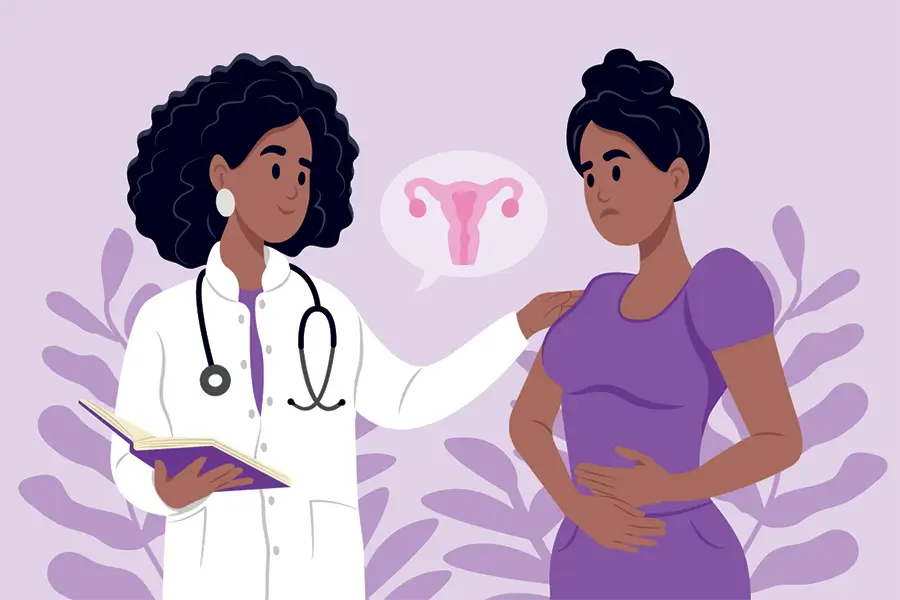Are My Fibroids Large or Small?
Uterine fibroids are incredibly common noncancerous growths composed of muscle and fibrous tissue that form in or on the uterus. While many women will experience no noticeable symptoms, others may have to deal with a variety of negative impacts on their physical and emotional well-being.
One of the factors that can influence the severity of those effects is the size of the fibroids. Understanding the range of fibroid sizes and recognizing the potential symptoms can help you figure out if your fibroids may be larger than usual, empowering you with information as you seek the right kind of medical help.

How Are Fibroid Sizes Measured and Classified?
Fibroids can manifest in a wide variety of sizes and shapes. Some might be microscopic and invisible to the naked eye, while others can grow very large. Medical professionals often use centimeters (cm) to express measurements. Here’s an approximate size guide:
- Seedling: These tiny fibroids are typically less than 1 cm in diameter. Most often, they are only detected during imaging scans.
- Small: Fibroids in this category can range from 1 cm to around 5 cm in diameter.
- Medium: A medium-sized fibroid can be between 5 cm and 10 cm in diameter.
- Large: Large fibroids exceed 10 cm in diameter, and depending on their location, could begin to put pressure on surrounding organs.
- Giant: These massive growths are rare but can become large enough to significantly distort the shape of the uterus.
Beyond measurements, fibroids are further classified based on their location within the uterus:
- Intramural: Situated within the muscular wall of the uterus, this is the most common type of fibroid.
- Subserosal: Found on the outer surface of the uterus, subserosal fibroids extend into the pelvic area.
- Submucosal: Developing in the inner lining of the uterus, submucosal fibroids may protrude into the uterine cavity.
- Pedunculated: When a subserosal or submucosal fibroid grows a stem-like base, it becomes pedunculated.
How Can Fibroid Size Affect Me?
Although the sheer size of a fibroid isn’t always a direct indicator of symptom severity, larger fibroids generally have a greater likelihood of causing problems or intensifying existing ones. Here’s what you need to keep an eye out for:
- Disruptive Menstrual Bleeding: Large fibroids, particularly submucosal ones, are often associated with abnormally heavy or prolonged periods, as well as spotting between periods. This kind of irregular bleeding can contribute to anemia and a general feeling of weakness.
- Pelvic Pressure or Pain: The bulk of a large fibroid can press against the bladder, bowel, or even nerves, resulting in various forms of discomfort. These sensations can range from a dull ache to sharp pelvic pain or frequent feelings of fullness.
- Constipation or Urinary Issues: As large fibroids encroach on surrounding organs, they may interfere with digestive or urinary functions. Constipation, bloating, and frequent urination are all possible outcomes.
- Impact on Pregnancy: In some cases, large fibroids can complicate pregnancy by affecting conception, increasing risks of miscarriage, hindering fetal growth, or causing complications during labor and delivery.
Common Symptoms of Uterine Fibroids
It’s important to remember that not every woman with fibroids will experience noticeable symptoms. The size, location, and number of fibroids all play a role in the potential for impact. But beyond those influenced directly by size, here are some other common signs and symptoms of uterine fibroids:
- Lower back or leg pain
- Pain during intercourse
- A feeling of heaviness or fullness in the lower abdomen
- Abdominal swelling or enlargement
A Brief Look at Uterine Fibroid Embolization (UFE)
If your fibroids are causing troublesome symptoms and impacting your quality of life, it’s definitely time to consult with a doctor. While there are other treatment options available, one minimally invasive procedure worth considering is Uterine Fibroid Embolization (UFE).
During a UFE, tiny particles are injected through a catheter to block the blood supply to the fibroids. This causes the fibroids to shrink and eventually die off. UFE can be a good option for women with larger, symptomatic fibroids who want to preserve their uterus and potentially avoid major surgery.
Some women choose Uterine Fibroid Embolization (UFE) over a hysterectomy for several reasons. UFE is a minimally invasive procedure that preserves the uterus, offering a shorter recovery time and fewer potential complications compared to a hysterectomy. This means the option for future pregnancies remains intact. Additionally, UFE avoids the hormonal shifts and potential for early menopause that can be triggered by a hysterectomy. For women wanting to avoid major surgery, preserve their fertility, or experience a faster recovery with less risk, a UFE can be a highly appealing alternative to a full hysterectomy.
Reach out today
If you suspect you might have fibroids or are experiencing concerning symptoms, always seek proper evaluation and diagnosis from a qualified healthcare provider. You can turn to us for a consultation about your fibroids and any symptoms you are experiencing.
Our patients want to make informed decisions about treatment with a trusted, world-class medical group that supports an effective pain management plan.
We have responded with processes that are minimally invasive and limit your loss of work and personal time. Our experienced physicians and staff keep you informed at each step of the process.
We always provide a personalized evaluation, treatment, and pain management plan. Our support continues after treatment with a comprehensive follow-up plan.
